Along with fellow members of The Druid Order, Matthew Shaw makes a 556-mile pilgrimage to the Island of Iona.
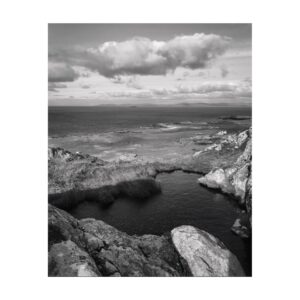
In 2019 I undertook a pilgrimage using only walking and public transport — a 556 mile trip to the Island of Iona. The trip had been organised by members of The Druid Order, a group I have been part of for the past decade or so. There is a long tradition of trips both within the UK and abroad with the Druids, and Iona was a place I had wanted to visit for as long as I could remember.
Although sometimes seen as religious, The Druid Order is not a religion, and some companions in the order practice other religions alongside their Druidic spirituality, including Christianity. A former companion of the Druid Order, the artist and author Ithell Colquhoun was ordained as a Deaconess in the Saint Église Celtique en Bretagne. No one was planning to be ordained on our Iona trip, but we all had our reasons to want to make the journey. I was particularly interested in the ancient history of the island, and also its strong spiritual continuum from pre-Christian beliefs through to the introduction of Christianity and the arrival of St Columba from Ireland in AD 563, who, along with his twelve companions, founded the monastery on Iona.
My journey started with a short walk from my front door across the road to Christchurch railway station. I took the South West Trains service to London Waterloo, and then three tube trains to Tottenham Hale Station where I met my friend James. He walked me through empty streets — and deserted, desolate swathes of land awaiting development — to his house. The admittedly short and familiar first leg of the journey was complete, but on this occasion it marked the beginning of a pilgrimage rather than just a trip to London.
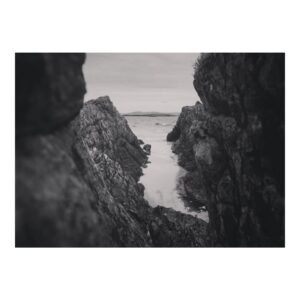
We set off early the next morning to take the overground and tube to London Euston and catch a train to Glasgow Central — a five-hour journey from England to Scotland. We spent much of the journey reading and talking about what makes Iona so special. In addition to its ecclesiastical history, there is Iona’s geology; the conflicts and invasions the island has endured and weathered: the wildlife that has made the island its home. We also talked of matters related to meditation and the effects that meditating regularly had on our lives. This was interspersed with periods of time looking out of the window, the world passing by, architecture and landscapes changing.
Before we knew it, we had arrived in Glasgow. We had just enough time for lunch before we walked to Queen Street station. This next leg of the journey took us through unfamiliar territory, a wonderful journey on a rickety old train destined for Oban. En route our friend Ashley walked through the train and joined us for the remainder of the journey. Having researched a lot more about Oban than James or I, Ashley was full of recommendations. We sat at a table, excitement growing for our time there, and for meeting up with the rest of the party, who were travelling by various methods from across the UK.
On arriving in Oban James and I checked into our twin room in the B&B opposite to the port. We were well situated for a very short walk to the boat the following morning. After dumping our bags we headed out to meet up with everyone else at the pub, where we ate, drank, made plans for the next day and shared stories, theories and folklore from Mull and Iona. It was such a diverse group of people in age, interest, and background, and was all the richer for it. The next week was going to be fun. The following morning, we explored the fish market and some of the shops before collecting our bags and heading to the ferry. Off we went on the boat to Mull.
Once we had arrived on Mull, James and I travelled around the Island with Susan, Colin and Rudi. Colin and Susan had hired a car for the day so that we could visit some ancient sites before we left for Iona later that afternoon. We stopped off at Lochbuie Stone Circle. We explored the area around the site first, discussing the line of trees, how the landscape features looked in relation to the standing stones, questioning why this particular site was chosen thousands of years ago to be marked with a circle. We then spent some time slowly walking around the stone circle, greeting each stone in turn, spending a little while standing by each one. We each chose a stone and a position in the circle for the first part of a meditation before swapping positions and perspectives. Our conscious and unconscious minds were set to work, and we left with fuel for dreams and strong memories.
It was time to turn our attentions to the more mundane matter of getting to the ferry on time, so off we headed for the next, much smaller port, to cross over to Iona. At the ferry the rest of our party arrived we crossed as foot passengers.
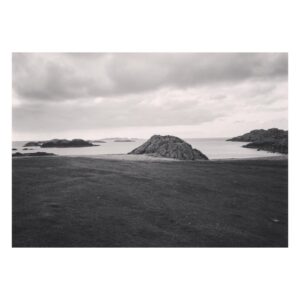
There is an energy and atmosphere to Iona that is unlike any other place I have been. It’s partly to do with the deep sense of peace I felt on the Island. There’s also the freshness on the breeze, the mysterious and beautiful rock formations, and the exquisite green marble stones. There are beaches and hills and stunning views. There’s the birds, animals, and warm and welcoming people that call Iona home.
On the way to our hotel, we spotted a Sheela-na-Gig high up on one of the ruined walls of the Augustinian Nunnery, which was founded in 1208. Some folk on the island believe that a Druidess who lived on Iona may have been a custodian of this Sheela prior to Saint Columba’s arrival in 563 CE. It’s possible that this Sheela-na-Gig, already of greater antiquity, was re-used when the Nunnery was built. The stone is certainly different and seems older than the stone that surrounds it in the fabric of the building.
The simple pleasure of eating, drinking and walking together is very good for a group. We did a lot of all three. Especially good was a long walk across the length of Iona with packed lunches of sandwiches, fruit juice and crisps. We spent a long time on one of the beaches looking out to sea, meditating on this ancient landscape and all of the history and legends that surround the island. The evenings were spent in front of a log fire: its warmth and the fine single malt whiskeys on offer kept us warm and soon sent us off to bed each night. That and the distances covered during the day, giving us a feeling of a healthy tiredness, of miles covered on foot.
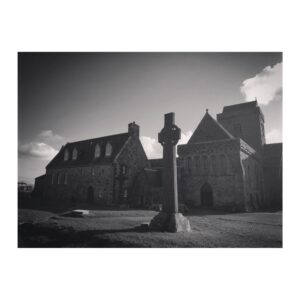
Some of us attended the service in the Abbey on the first evening after we arrived. Here was a Christian service quite different from any I had previously experienced. I should make it clear that I’m not a big church-goer, but was dragged along to church in Sandbach as a child, sitting through a few years of Sunday school, and continued to attend services from time to time as a teenager. Occasionally, in adulthood, I have chosen to go to a service for one reason or another too. This time in Iona I could see more clearly than ever before why people might be drawn to this particular spiritual path. I continued to attend the evening services each day for the whole week. It felt like there was much more of a focus on an animist world, admittedly within a Christian structure but somehow the two systems fitted together without conflict. An almost universalist approach to multi-faith acceptance and integration. Interesting and refreshing. Connection with nature and close observation of the seasons also played a large part of the sermons and attention of this congregation. Perhaps it was partly to do with the island itself, but it felt harmonious and quite beautiful.
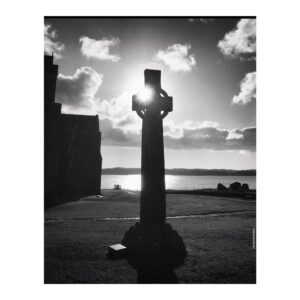
The stones and rock formations on Iona are striking, almost alien even, compared to the landscapes I’m familiar with. On a walk around Iona it’s very probable that you will happen across a hermit’s cell, a natural rock formation, or something man-made from a few hundred or even thousands of years ago — or perhaps all three. The layers of history on Iona, built on the foundations of pre-history, are rich and complex, fascinating and ultimately unknowable. There is a mystery that makes the place all the more interesting, the endless knot with strands unfurled as clues to an elusive past.
After a week of peace, meditation and exploring it was time to make the long journey home. As soon as we were over the small stretch of water to Mull, James and I got on a bus. We sat at the very front of the double decker, taking in the astonishing views across the island. Then back onto another ferry to Oban and another chance to wander around the town. A liminal place, the last stop or first point of arrival. An ancient crossroads connecting isolated island life with mainland Scotland. And so we travelled south, back to Glasgow where we spent the night.
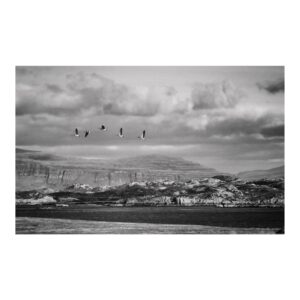
The following we day we headed to Govan Old Church. We had found connections between Govan and Iona, and had also spotted some very interesting looking carved stones we wanted to see in person. We took a cab to Govan. The cabbie seemed quite amused by two Englishmen wanting to wander around Govan but I found the place to be friendly and full of treasure. The first story from Govan concerns a previous minister of the parish, George MacLeod, who was ordained as a Church of Scotland minister in 1924. After spending some years preaching in Edinburgh, George opted to leave St Cuthbert’s Church for Govan. George was a socialist and pacifist deeply concerned with the poverty and unemployment faced by those less fortunate in society. Govan was a place that George thought needed some love and attention and also some practical help. George became an important figure in Govan, aware of his own privilege and with a real determination to help people within the community. After two years there, George had something of an epiphany during Easter of 1932. Some say this followed a breakdown, but whatever the cause this moment of change would influence the rest of his life. In 1938 he made the decision to leave Govan and to found the Iona Community. The idea George had was to rebuild the ruined Iona Abbey. He would be helped in this by unemployed labourers from Glasgow, working with church ministers and local students. The Iona Community developed from these small beginnings to become an international community, with a presence in Govan as well as on Iona itself. The Community was founded on four principles: mission, political involvement, a ministry of healing, and worship — elements that George thought could connect the Church with an industrial age. Here we had a forward-thinking minister making a distinct difference in a community he helped to bring together.
The second story about Govan Church concerns archaeology and carved stones.
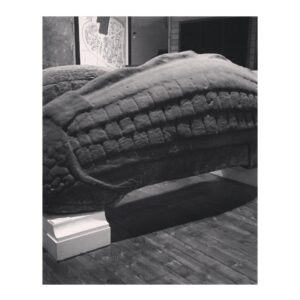
The Govan Stones are the carved stones to which I refer. They were discovered on a dig of the early medieval churchyard and include the Govan Sarcophagus, which was discovered in Govan Old’s graveyard in 1855 when a grave was being dug. Also discovered were five Anglo-Scandinavian Hogbacks, which are sculptures dating from the 9th-11th centuries AD. A televised Time Team dig discovered more artefacts in 1996. In fact, new finds are still turning up to the present day — the latest finds are from September 2023 when a previously undiscovered early medieval carved stone was unearthed by Professor Stephen Driscoll. James and I marvelled at these intricately carved stones. They struck us as messages from the past; indelible messages, if we could but interpret their meaning.
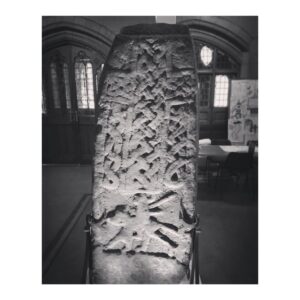
With these carvings in mind and a pebble in my pocket from Iona, it was time to leave for London. On the journey south into England I watched the landscape become familiar again. My mind was still very much with the stones from Govan and Iona though, the histories and mysteries of the ancient past. After another night in London, I made the final leg of my journey, alone, back to Dorset. I arrived a slightly different person than I had left. There was so much to think about all that I had seen and felt during my week in Iona. Community was certainly something I had thought a lot about, as well as the transformative work George MacLeod had done. I was taken by how the ancient past could be such a levelling and unifying thing to base community in and around — an idea which still informs a great deal of the work I do to this day.